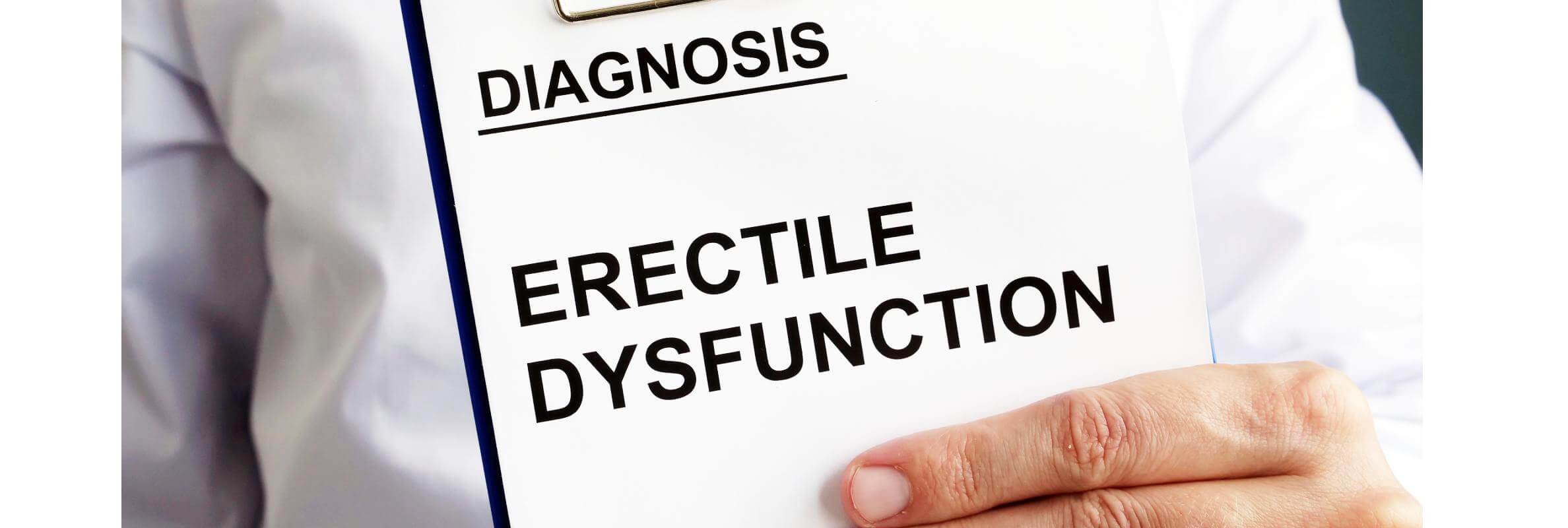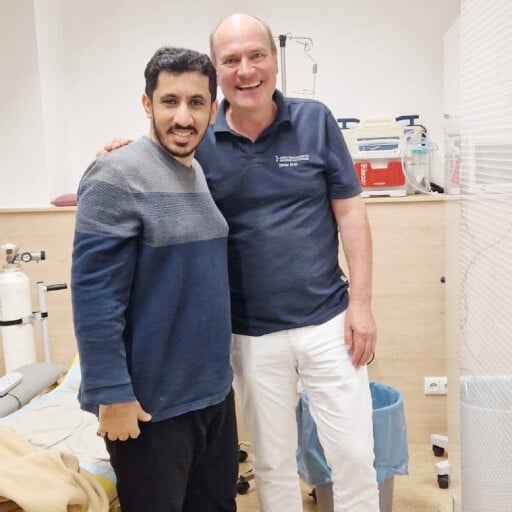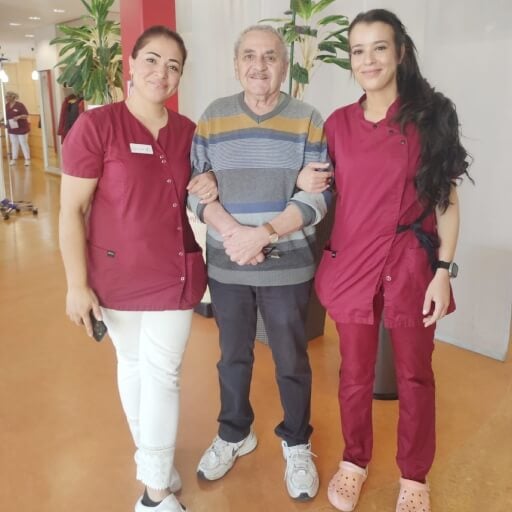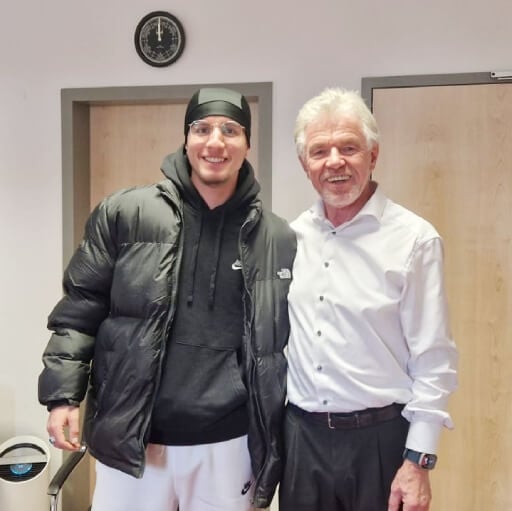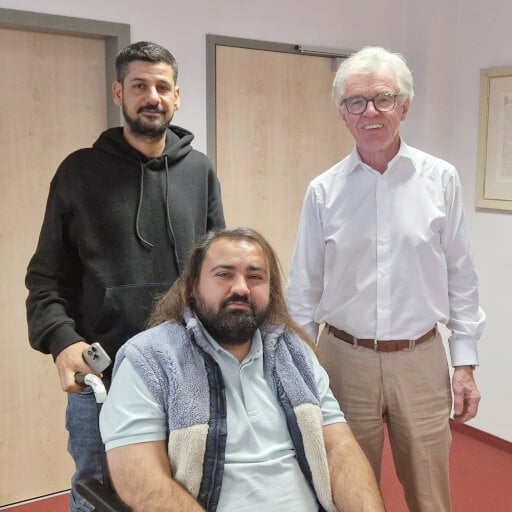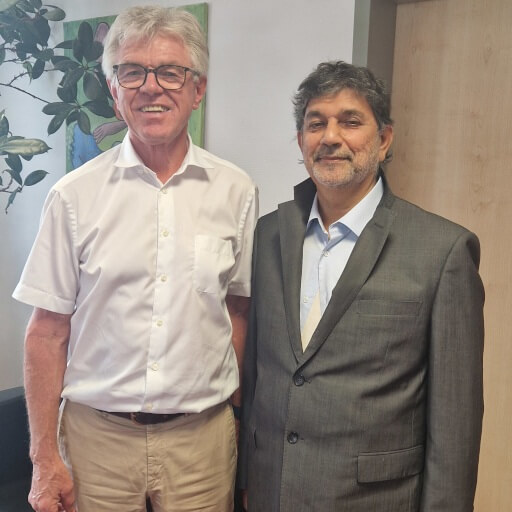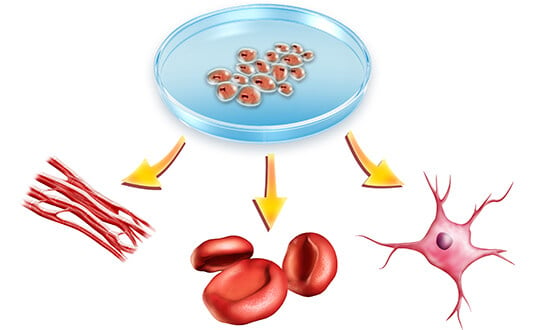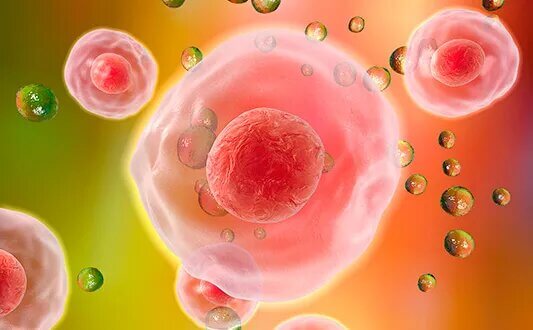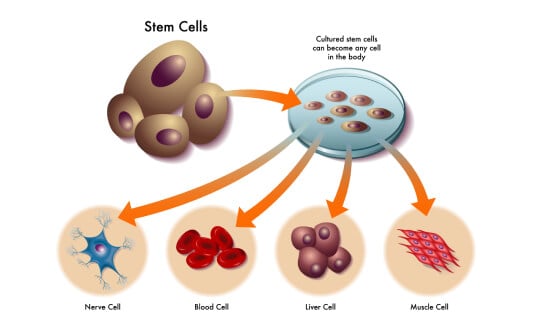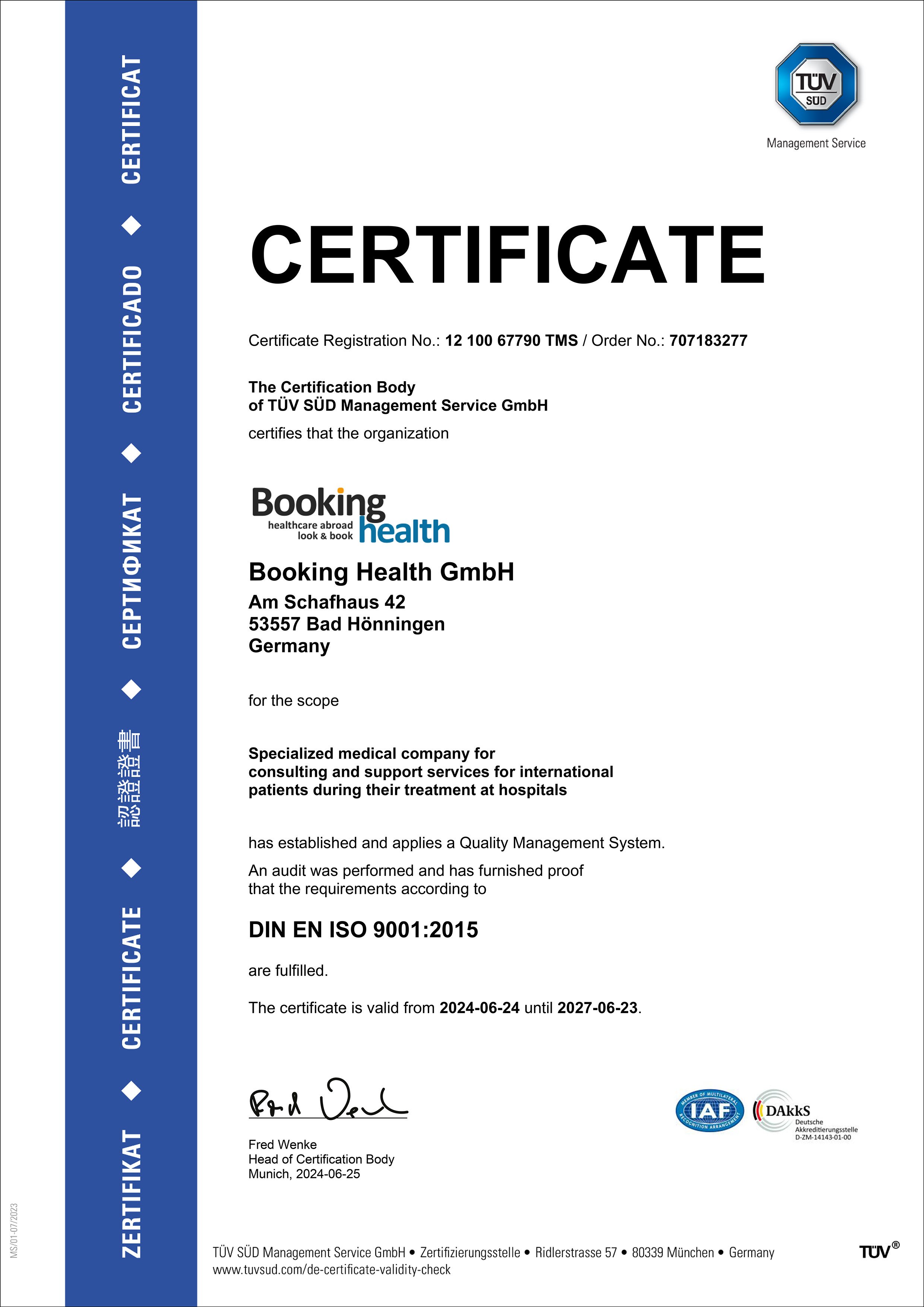Erectile dysfunction (ED) is a disease in which it is impossible to achieve a sufficient erection for sexual intercourse. This pathology can have many reasons. Depending on the origin, erectile dysfunction requires different approaches to treatment.
Studies in Germany show ED prevalence rates between 18% and 48% among middle-aged men, with age being the strongest risk factor [1]. The prevalence and severity of ED increase significantly with the number of risk factors present, reaching 68.7% in men with multiple lifestyle risk factors and comorbidities [2].
Cellular regenerative medicine has been developing in recent years [3]. Clinical trials have demonstrated that stem cell therapy (SCT) can improve erectile function in patients who are unresponsive or resistant to standard medical treatments like PDE5 inhibitors [4]. In Germany, stem cells (SC) are used to enhance male potency with promising results. Recent meta-analyses show that intracavernosal stem cell therapy (SCT) may significantly increase erectile function scores at six months compared to baseline [5].
Types of erectile dysfunction (ED)
There are many classifications of erectile dysfunction. The most important is the etiological classification, which divides this disease into groups depending on the cause. Treatment tactics depend on the cause of the deterioration of an erection.
The following types of erectile dysfunction are distinguished:
- Psychogenic – associated with psychological factors, this mainly occurs in young men
- Organic – often occurs in old age, it is associated with anatomical and functional disorders in the body
Organic erectile dysfunction has the following types:
- Vasculogenic or vascular – caused by damage to blood vessels or deterioration of their condition due to age-related changes
- Neurogenic – the result of damage to peripheral nerves, most often detected in diabetes mellitus (diabetic erectile dysfunction) and in men after a prostatectomy
- Endocrine – a group of diseases that lead to a decrease in testosterone production
- Penile – associated with penile diseases (the most common cause is Peyronie's disease)
Organic erectile dysfunction can rarely be cured once and for all. Doctors usually use a permanent, symptomatic treatment. It is applied on demand and can improve erectile function for a short time, which is sufficient for intercourse. Another option is supportive therapy, which slows down the further progression of the pathology. If conservative treatments are unsuccessful, sometimes it is necessary to resort to surgical methods. However, advances in regenerative medicine are changing the medical landscape.
Risk factors of erectile dysfunction (ED)
The disease is extremely common among elderly patients. An epidemiological study in Cologne showed that the prevalence of the pathology is 19.2% in men aged 30 to 80 years. However, indicators significantly depended on age. In different categories of men, the incidence of erectile dysfunction (ED) ranged from 2.3% to 53.4%.
Thus, age is the main risk factor for this pathology, with erectile function declining progressively in older men. Here are a few more adverse factors that can increase the risk of the pathology:
- Low levels of physical activity
- Smoking
- Obesity
- Hypercholesterolemia
An MMAS study found that regular exercise and physical activity reduced the risk of erectile dysfunction by 70% over 8 years. Maintaining an active lifestyle is crucial for overall sexual health.
Diagnostics of erectile dysfunction in Germany
For a successful treatment of erectile dysfunction, it is important to determine the cause and mechanisms of the disease. This is the main goal for doctors who are involved in the diagnostic process.
The doctor begins by looking at the patient's medical history. He clarifies all the risk factors that could lead to one or another type of erectile dysfunction.
Vasculogenic ED usually occurs due to arterial hypertension, obesity, smoking, or diabetes mellitus. It is usually identified in older men. It is often combined with ischemic heart disease and atherosclerotic lesions of the vessels of the legs and brain.
Neurogenic ED can be central or peripheral. Central develops due to brain tumors, Parkinson's disease, multiple sclerosis, or spinal hernias in the lumbar region. Peripheral develops against the background of diabetes mellitus, alcoholism, polyneuropathy, or surgery (usually a radical prostatectomy).
Anatomical (penile) ED develops in patients with Peyronie's disease, after a penile fracture or other injuries. The cause of this disease can be congenital pathologies, such as curvature of the penis, hypospadias, epispadias, or micropenis.
Endocrine ED can be caused by any diseases and conditions that lead to a decrease in testosterone levels. It may be primary hypogonadism, caused by damage to the testicles or the result of insufficient or excessive production of other hormones that affect androgen secretion. Possible endocrine causes are hyperprolactinemia, hypothyroidism, or Cushing's disease.
Psychogenic ED can be generalized or situational. In a case of generalized erectile dysfunction, the person is not capable of sexual arousal. Depression or another mental disorder may be the cause. Situational psychogenic ED can be associated with a specific partner or a situation tied to a place or time.
Drug-induced erectile dysfunction is classified separately. This is erectile dysfunction due to various mechanisms, which are caused by drugs. They can affect blood vessels, nerves, and hormone levels, but these are usually temporary side effects that disappear when the drug is stopped. ED is mainly caused by drugs, antiandrogens, antipsychotics, antidepressants, antiallergic (antihistamines) medications, and certain medications for treating hypertension (beta-blockers and potassium-sparing diuretics).
Some diseases can already be detected in the patient upon admission and are recorded in his medical history. There are a number of pathologies that urologists or andrologists can identify straight away during an appointment. The doctor sometimes reveals an enlarged prostate, anatomical anomalies of the penis, small testicles, etc.
Here are the basic laboratory tests that aim to detect the cause of erectile dysfunction:
- Determination of total testosterone in the morning blood
- FSH, LH, prolactin, thyroid hormone testing – in cases of low levels of testosterone
- Blood sugar levels on an empty stomach and lipid profile (cholesterol, triglycerides, lipoproteins of different classes) to identify hyperlipidemia-associated erectile dysfunction
Special tests are:
Nocturnal swelling and stiffness of the penis. They determine the preservation of the erectile mechanism. The rating is for 2 nights or more. The occurrence of spontaneous nocturnal erections up to 60% for at least 10 minutes, indicates the preservation of the erectile mechanism.
Intracavernous injection test. After the injection of antispasmodics into the penis, a hard erection (inability to bend the penis) should occur in no more than 10 minutes and last for at least 30 minutes. If violations are found, duplex scanning (ultrasound) of the vessels of the penis will be performed.
Ultrasound of the arteries of the penis. Blood pressure of 30 mm Hg is considered the norm, with a resistance index of more than 0.8. With a normal result, vasculogenic (vascular) erectile dysfunction is excluded.
Standard treatment plan for erectile dysfunction (impotence)
The main directions for the treatment of erectile dysfunction are:
Elimination of the causes of erectile dysfunction. This is possible in a limited number of cases of psychogenic ED, traumatic vascular injury, and some endocrine diseases. In most cases, the disease cannot be completely cured.
Elimination of risk factors. Under their influence, the disease progresses. Patients are advised to make lifestyle changes, such as moving more, losing weight, keeping blood pressure at a normal level with medication, and eating healthy foods. All these measures can improve the condition of blood vessels and normalize metabolic processes and hormone levels, and via these, enhance male potency naturally.
Symptomatic treatment. Used to achieve an erection just before intercourse. For this, various groups of drugs (most often a type 5 phosphodiesterase inhibitor) and vacuum devices (negative local pressure therapy) can be used.
The treatment plan is usually divided into three stages. First-line therapy is performed first. At some point, it stops working. Doctors then resort to second-line therapy. When these measures also stop working, only third-line therapy remains, which is surgical.
First-line therapy for erectile dysfunction
Therapy depends on the type of erectile dysfunction. Psychological impotence is most common in young men. It is treated with psychotherapy, antidepressants, and anxiolytics (relieve anxiety). If the reason is overwork, it is necessary to improve the overall well-being, increase efficiency, normalize weight, and support healthy erectile function.
In cases with the development of endocrine erectile dysfunction, the normalization of hormonal balance is required. If the patient has primary testicular hypogonadism, testosterone medications can be prescribed. Decreased testosterone levels can be caused by other endocrine diseases, since hormones regulate androgen production. In this case, doctors may use other drugs, for example, for hypothyroidism, for hyperprolactinemia, or for hypogonadotropic hypogonadism.
Regardless of the type of endocrine disorder, taking hormones or their antagonists usually helps to quickly normalize hormonal balance and testosterone levels. These measures can serve for erectile function rehabilitation, but the patient is prescribed lifelong hormone therapy. When managed properly, hormone treatment can enhance male potency.
Vascular ED is the most common type of ED. It is treated with PDE5 inhibitors. These drugs dilate the blood vessels and provide blood flow to the penis to improve erectile function. Some medicines last only a few hours, while others last up to 2 days. These are the most common drugs for the treatment of impotence, but they only give a symptomatic effect.
In cases with an injury to the penis, blood vessels can be damaged. In these cases, a traumatic type of vasculogenic ED occurs. It can be cured with surgical revascularization (restoration of blood flow). The efficiency of such operations is about 70%. The operation cannot be performed in cases with veno-occlusive ED, due to unsatisfactory efficacy, and these cases are therefore excluded during the ultrasound examination before treatment.
Second-line therapy for erectile dysfunction
Doctors use other oral medications and topical medications. Specific drugs can be prescribed to improve erectile function when first-line therapies fail. The composition of these usually includes a vasodilator to improve the absorption of active substances. The effectiveness of these drugs is low – about 40%.
LNP therapy involves the use of local negative pressure. For this, the patient needs a vacuum device, a so-called pump. The vacuum draws blood and allows the patient to achieve an erection, even without sexual arousal. To prevent its outflow, latex rings are used; they are attached to the base of the penis.
The effectiveness of the procedure is 90%. However, after 2 years, it gradually decreases to 60%. And this method does not restore natural erectile function. Most men refuse LNP therapy within 3 months after starting it due to insufficient satisfaction with their intimate life: the mechanisms of erection are effective, but not physiological. 30% of patients experience side effects. The ring cannot be used for more than 30 minutes, due to the threat of tissue death, which limits the time of intercourse.
The efficiency of intracavernous injections is 85%. Twenty years ago, this was first-line therapy. Although the technique is effective, it has side effects and is therefore not suitable for everyone. 50% of men experience pain at the injection area and 5% have excessively prolonged erections. The risk of scarring of the penis is 2% and the risk of priapism is 1%.
Sometimes, endourethral administration of the drug is performed. The positive side of this procedure is obvious. There is no need to inject into the penis, but this procedure has drawbacks. Its efficiency is only 30-65%. Only high doses of the drug work, but they often cause systemic side effects. Up to 14% of patients complain of dizziness and 5% of patients have urethral bleeding due to improper intake. 30-40% of men experience pain. In addition, the achieved erection does not last long.
Third-line therapy for erectile dysfunction
The third-line therapy is penile prosthetics. A flexible or inflatable prosthesis can be used. The most natural erection is achieved with a 3-piece prosthesis.
The following complications are possible:
- About 5% of prostheses break down within 5 years
- The risk of infectious complications in the best clinics is 2-3%, and in the case of implantation of prostheses with antibiotics – about 1%
Disadvantages of standard treatment methods for ED
The standard treatment for erectile dysfunction has several disadvantages. It is not always effective and often dangerous. Only a small number of cases can be cured. In other cases, doctors use only symptomatic therapy, the effectiveness of which will gradually decrease.
Each method has its drawbacks. With the prolonged use of drugs, side effects are possible. They can also be caused by topical pump therapy or medication. Some complications are quite serious and require surgery or invasive procedures.
Surgery is the most effective method of obtaining long-term results, but such methods of treatment are not suitable for all men. It carries certain risks, namely, the aesthetic result is not always satisfactory, and the achieved erection is not caused by sexual arousal – this violates the physiology of sexual intercourse. Infectious complications are possible even in the best clinics in 2-3% of patients, and doctors have to reoperate on these patients. These limitations can significantly impact sexual function and levels of patient satisfaction.
Standard methods may soon be replaced by cellular regenerative medicine, as regenerative therapy is a fundamentally different approach. This is already in use in developed countries. Stem cells (SC) have been shown to work well for various types of erectile dysfunction. They repair tissue and improve innervation, blood supply to the penis, and hormone production. These methods are safe and long-lasting. Managing erectile dysfunction with stem cells in Germany offers patients a safe and reliable alternative.
| PDE-5 Inhibitors | Vacuum Devices (LNP) | Intracavernous Injections | Penile Implants | Stem Cell Therapy | |
|---|---|---|---|---|---|
| Mechanism of Action | Temporary vasodilation; improves blood flow during medication effect | Creates negative pressure to draw blood; mechanical erection | Direct injection of vasodilators into penis | Mechanical support for erection | Regenerates damaged tissues, blood vessels, nerves, and smooth muscle cells |
| Addresses Root Cause | No – symptomatic only | No – mechanical solution | No – symptomatic only | No – replacement solution | Yes – targets underlying pathology |
| Treatment Result Duration | 4-36 hours per dose | 30 minutes maximum per use | 1-2 hours per dose | Permanent device | Long-lasting (years); repeatable if needed |
| Invasiveness | Non-invasive (oral medication) | Non-invasive (external device) | Minimally invasive (injection before each use) | Highly invasive (surgery) | Minimally invasive (one-time injection procedure) |
| Suitable ED Types | Primarily vascular ED | All types (mechanical solution) | Vascular, neurogenic, mixed | All types when other methods fail | Vascular, neurogenic, post-surgical, endocrine, penile (Peyronie's) |
| Contraindications | Heart disease, nitrate use, severe liver/kidney disease | Bleeding disorders, anticoagulant therapy | Priapism risk factors, severe cardiovascular disease | Active infection, uncontrolled diabetes | Severe bleeding disorders, active infections |
| Patient Satisfaction | Moderate – requires planning, loses effectiveness over time | Low – 70% discontinue within 3 months | Moderate – 50% experience pain, requires self-injection | High – but not physiological, irreversible | High – physiological restoration without ongoing medication |
| Combination with Other Methods | Can be combined with lifestyle changes | Can be combined with medications | Often used when PDE-5 inhibitors fail | Final option when all else fails | Best combined with lifestyle modifications, can use PDE-5 inhibitors during regeneration period |
*Booking Health data and data from open sources
Intracavernous injection of MSCs in ED
Mesenchymal stem cells (MSCs) are a specific cell type that can be obtained from adipose tissue. While muscle-derived stem cells are another option, adipose tissue remains the preferred source. Adipose tissue contains much more of these cells than peripheral blood or bone marrow. MSCs are increasingly being used to treat diseases such as orthopedic, neurological, gynecological, urological, etc.
Injection of MSCs into the corpus cavernosum of the penis improves erectile function by enhancing the blood supply to this organ and its innervation. This approach is effective for penile, vasculogenic, and neurogenic erectile dysfunction. This method has the following goals:
- Blood sample or adipose tissue is taken (this procedure is performed under general or local anesthesia).
- The stromal vascular fraction containing blood or adipose-derived stem cells is derived. It contains a large number of blood or adipose-derived stem cells. Many methods can be used to obtain a fraction. In some clinics, they are obtained manually by enzymatic methods, in several stages, but in Germany, medical centers that conduct stem cell therapy have special equipment. They automatically obtain the stromal vascular fraction. This fraction contains many more stem cells that release growth factors, which allows doctors to provide better erectile dysfunction treatment outcomes.
- A fraction of the stromal vessels is injected into the intracavernous body at a dose of 4 ml. This number contains an average of 50 million mesenchymal stem cells. The dose is distributed evenly – usually in 6 different points. A tourniquet is used for 15 minutes to restrict the blood flow from the penis and reduce the migration of stem cells from the injection site.
Stem cells stimulate the regeneration of tissues of the penis, blood vessels, and nerves by releasing growth factors. They have long-term therapeutic, but not palliative or symptomatic, effects. After a course of stem cell therapy in Germany, the patient can expect their erection to last a long time. If necessary, the course of treatment can be repeated after several years. This procedure is an alternative to surgical intervention in cases where erectile dysfunction is not amenable to pharmacological correction or other conservative treatment methods, as stem cell injection into the penis rescues erectile function when other treatments fail. Many patients choose stem cell therapy for erectile dysfunction as a minimally invasive option.
Oleg, 59 years old. After the stem cell injections, I felt a slight burning sensation for several days. There was swelling, but it did not cause severe discomfort. A few weeks later, I felt a second youth! In the best case, before an erection occurred once in three, but now the wife is completely satisfied. Previously, I only had PDE5 inhibitors in my arsenal, but recently, they stopped working. This prompted me to travel to Germany for diagnosis and treatment. Thanks to Booking Health for the whole organization. I was placed in a good clinic and saved about 30% on medical procedures.
Stem cell therapy for neurogenic ED in Germany
One of the common problems in older men is trauma and degeneration of the nerves of the pelvis and penis. Neurogenic erectile dysfunction is most commonly caused by diabetes mellitus (diabetic erectile dysfunction). This also happens after a prostatectomy.
Treating erectile dysfunction of neurogenic origin is very difficult. In fact, there are no effective drugs for restoring an erection with nerve damage. PDE5 inhibitors can be used for vascular erectile dysfunction. Testosterone preparations can be used for endocrine ED, but there is nothing doctors can do about nerve damage.
However, stem cell injections are showing promising results. These adipose-derived stem cells are injected both directly into the corpora cavernosa and intravenously. A similar effect can be achieved in the second case, but this will require a larger number of stem cells. Therefore, intracavernous injections are performed more often.
Clinical trials show excellent treatment results. Complete regeneration of the cavernous nerves occurs under the action of stem cells – regenerative therapy demonstrates superior outcomes in this. The growth factors secreted by stem cells promote tissue healing.
At the same time, the use of cellular technologies is completely safe. Mesenchymal stem cell therapy has shown excellent safety profiles across multiple clinical trials worldwide. The treatment works well and is well tolerated by patients.
The period of time required for the restoration of the erection:
- The intermediate results can be felt at the end of the first month after stem cell injections
- The significant results can be achieved in a month and a half
- The best results in most trials were developed 3 months after the procedure
There are various scales by which an erection is assessed. After the introduction of stem cells, the average score on the IIEF-5 scale by the end of the 3rd month increases from 6-8 to 24-25 points. The strength of erection on the Unem scale increases from ER3 to ER5. Electromyographic data of the corpus cavernosum of the penis show a positive dynamic.
In recent years, more and more research has been carried out in the field of cellular regenerative medicine, particularly cell therapy for erectile dysfunction (SC ED). These investigations are aimed at studying the effect of stem cells on erection. More and more clinics in developed countries are introducing this regenerative medicine technique into medical practice. Today, you can take advantage of the advances in cell therapy for erectile dysfunction (SC ED). To do this, you can visit one of the German clinics that practice this method of treating erectile dysfunction.
Stem cell therapy for erectile dysfunction has the following advantages:
- The patient is injected with autologous cells, not allogeneic, which makes the procedure safe.
- Long-term results, not symptomatic as is the case with drugs
- The treatment method is minimally invasive and well tolerated by the patient
The disadvantages of the method include:
- Relatively high cost in comparison with other conservative treatment methods
- Delayed effect – the first result will be apparent in 1-1.5 months, and the maximum result will be achieved in 3 months
The use of stem cells therapy is usually recommended when the possibilities of standard conservative therapy have already been exhausted. In this case, the patient wants to restore a full intimate life and at the same time, wants to avoid surgery (phallus prosthetics).
Here is the story of Thomas, confirming all the written above. After all the available treatments failed him, taking over €20,000 out of his pocket, stem cell therapy provided him with the desired result without ongoing medication or invasive surgery.
Valery, 35 years old. My diabetes began to cause complications. The disease was diagnosed at an advanced stage, so I did not receive treatment for a long time. As a result, my erection almost completely disappeared. For some time, it was possible to maintain it with the help of medications prescribed by the doctor. After about 2 years, they stopped working. I have no financial problems, so I went to Germany for treatment. I was offered phallus prosthetics, because the tests showed that it was unlikely to be possible to restore an erection with the help of drugs. I refused the operation. Then the doctors suggested an alternative - stem cells - and it worked! I first pleased my wife a month after the procedure. After 3 months, my "tool" started working without "failures", the procedure was carried out 2.5 years ago, so far, everything is in order.
Stem cell therapy for endocrine ED in Germany
Endocrine erectile dysfunction is caused by low testosterone levels. The patient can constantly receive injections of this hormone, but with the help of injected stem cells, its endogenous formation can be enhanced – this method of treatment is more physiological and does not require constant medical support.
With age, the production of pluripotent stem cells decreases in humans, so tissues are renewed less intensively. Gradually, testicular sclerosis occurs – the number of Leydig cells responsible for testosterone levels decreases by 1% annually. Androgen production also decreases by about 1% annually. With a lack of male hormones, libido decreases and sexual dysfunction occurs.
Pluripotent stem cells can be donor cells. They can be administered intravenously at intervals of 2-3 months. With this procedure, you can dramatically increase the level of testosterone in the blood of patients that are 50-60 years old and restore erectile function naturally. Gradually, he will reach the level of youth as different cell types in the testes are regenerated. The results last for a long time, as the procedure does not cause temporary overproduction of androgens, but increases the number of Leydig cells in the testes.
Konstantin, 62 years old. For a long time, I noticed that my erection and desire had weakened. I went to the doctor and he prescribed testosterone shots for me. I have had this treatment for about 3 years and it has worked. I was recently in Germany for another illness. When it came to my problem, the doctor offered to use stem cells for a long-term solution for me. After several intravenous infusions, I did not feel any changes. However, I have not taken testosterone again and my erection remains excellent, despite not receiving hormone injections for over 2 years! I recently had diagnostic tests, and the doctors at the clinic said that my testosterone levels were about the same as a 40-year-old man.
The number of people treated for erectile dysfunction with stem cells (SC Tx ED) is now in the thousands. Doctors have not recorded a single case of severe complications. This procedure is safe, effective, and provides long-term results by stimulating tissue regeneration.
Clinical Feedback on Stem Cell Therapy for ED From the Healthcare Professionals
Dr. med. Gerhard Siebenhüner is the Head of the Department of Alternative Medicine at Clinic of Advanced Biological Medicine Frankfurt am Main. The department specializes in regenerative medicine approaches for various conditions. Stem cell therapy has been among his spheres of competence since 2005.
According to Dr. Siebenhüner, "Stem cells are regenerative cells, that is, they have regenerative properties. If tissues do not work properly or any dysfunction occurs due to age-related changes... stem cells can be used to restore tissues." In men with erectile dysfunction, the stem cell therapy (SC Tx ED) addresses vascular damage, nerve degeneration, and hormonal imbalances.
Adipose-derived stem cells are the easiest to harvest. As Dr. Siebenhüner explains, "there is a lot of adipose tissue in the human body. Therefore there are also many stem cells in this tissue, and their number is not limited as, for example, in the bone marrow. Up to 500 million stem cells can be harvested."
It is essential to note that stem cell therapy results develop gradually. "First, one course of treatment is carried out. If after 3 to 6 months there is no desired result, the course of treatment can be repeated. It is after the second course of treatment that the desired result is most often achieved."
However, stem cell therapy is not a universal solution. Dr. Siebenhüner emphasizes: "Doctors can successfully use the methods of classical medicine while supplementing them with stem cell therapy." Treatment effectiveness varies by individual case and must be combined with other medical approaches.
How to go to Germany for stem cell therapy for ED?
Previously, it was rather difficult to go to Germany for treatment, since you had to look for a clinic yourself, contact its administration, wait for an invitation for treatment, translate documentation, and look for an interpreter for oral communication. A person had to spend a huge amount of time, effort, and money on organizing a trip, but this is no longer required, since Booking Health can take over all the organizational issues.
You can use Booking Health service for the selection of a clinic. If necessary, our specialists will help you choose the best center that specializes in the treatment of erectile dysfunction using stem cells (SCT for ED). There, you will undergo diagnostics and therapy that will bring you the best results. In particular, many men receive treatment at the Clinic of Advanced Biological Medicine Frankfurt-am-Main .
The clinic's specialists determine the cause of erectile dysfunction and carry out all stages of stem cell therapy – stimulation aimed at increasing the number of multipotent stem cells in the organism, harvesting and cultivating stem cells, replantation of stem cells into the body, and supportive fluid therapy. In most cases, one visit to the clinic is enough to achieve the desired result. The cost of stem cell treatment for erectile dysfunction in the Department of Alternative Medicine starts from €22,536.
The Booking Health company provides the following benefits:
- We will help you choose a clinic based on statistics, equipment, specialization, experience, and results of cell therapy for erectile dysfunction (SCT for ED).
- The average cost of treatment for you will be much lower, due to the absence of overpricing and additional coefficients for foreign patients.
- We will shorten your waiting time for the start of treatment and book an appointment on convenient dates for you.
- We will arrange your communication with the doctor at the end of the treatment program.
- We will prepare and supervise your medical program.
- We will monitor the billing, the volume of services provided, and will refund any unspent funds at the end of your treatment program.
- We arrange insurance for you against an increase in the cost of treatment, in case of complications (coverage of €200,000, valid for 4 years).
- We will buy and send the medicines prescribed by your doctor from Germany.
- If necessary, we will organize additional examinations, treatment, and rehabilitation in German clinics.
- We will provide communication with the medical center upon the completion of your medical program.
We will solve all your travel issues, book your flights and hotel, meet you at the airport in Germany, and take you to a clinic or hotel. At the end of your course of treatment, we will take you back to the airport.
Stem Cell Therapy: Patient Stories with Booking Health
Frequently Asked Questions About Stem Cell Therapy for Erectile Dysfunction in Germany
Send request for treatmentStem cell treatment for erectile dysfunction in Germany involves harvesting mesenchymal stem cells (mainly blood or adipose-derived stem cells) and injecting them into the penis to regenerate damaged tissues for long-term results.
Stem cell vs traditional ED treatment differs fundamentally: conventional treatments provide temporary symptom relief, while stem cells aim to repair underlying tissue damage and restore sexual health through regeneration rather than just managing symptoms.
Mesenchymal stem cells Germany uses are harvested from the patient's own blood or adipose tissue. Adipose stem cells ED treatment is widely used because adipose tissue contains abundant stem cells (up to 500 million can be extracted from a single procedure).
Safety of stem cell therapy in ED in Germany is well-established; clinical trials report no serious adverse effects. German clinics follow strict protocols and use autologous cells, which eliminates rejection risks and ensures patient safety.
The cost of stem cells for ED in Germany starts from €22,536. Booking Health helps reduce costs by eliminating additional foreign patient fees.
Choose treatment abroad and you will for sure get the best results!
Authors:
This article was edited by medical experts, board-certified doctors Dr. Nadezhda Ivanisova, and Dr. Bohdan Mykhalniuk. For the treatment of the conditions referred to in the article, you must consult a doctor; the information in the article is not intended for self-medication!
Our editorial policy, which details our commitment to accuracy and transparency, is available here. Click this link to review our policies.
Sources:
[1] Englert H, Schaefer G, Roll S, Ahlers C, Beier K, Willich S. Prevalence of erectile dysfunction among middle-aged men in a metropolitan area in Germany. Int J Impot Res. 2007;19:183-8. doi:10.1038/sj.ijir.3901510. [DOI]
[2] Hallanzy J, Kron M, Goethe VE, Köhn FM, Schmautz M, Arsov C, et al. Erectile dysfunction in 45-year-old heterosexual German men and associated lifestyle risk factors and comorbidities: results from the German Male Sex Study. Sex Med. 2019;7(1):26-34. doi:10.1016/j.esxm.2018.11.004. [DOI] [PMC free article]
[3] Pérez-Aizpurua X, Garranzo-Ibarrola M, Simón-Rodríguez C, García-Cardoso JV, Chávez-Roa C, López-Martín L, et al. Stem cell therapy for erectile dysfunction: a step towards a future treatment. Life (Basel). 2023;13(2):502. doi:10.3390/life13020502. [DOI] [PMC free article]
[4] Wang B, Gao W, Zheng MY, Lin G, Lue TF. Recent advances in stem cell therapy for erectile dysfunction: a narrative review. Expert Opin Biol Ther. 2023;23(6):565-73. doi:10.1080/14712598.2023.2203811. [DOI] [PMC free article]
[5] Patel AA, Shafie A, Mohamed AH, Rizaev J, Mallick AK, Qasim MT, et al. The promise of mesenchymal stromal/stem cells in erectile dysfunction treatment: a review of current insights and future directions. Stem Cell Res Ther. 2025;16:98. doi:10.1186/s13287-025-04221-9. [DOI]
Read:
Stem cell therapy and treatment in Germany
Article menu:
- Types of erectile dysfunction (ED)
- Risk factors of erectile dysfunction (ED)
- Diagnostics of erectile dysfunction in Germany
- Standard treatment plan for erectile dysfunction (impotence)
- Disadvantages of standard treatment methods for ED
- Intracavernous injection of MSCs in ED
- Stem cell therapy for neurogenic ED in Germany
- Stem cell therapy for endocrine ED in Germany
- Clinical Feedback on Stem Cell Therapy for ED From the Healthcare Professionals
- How to go to Germany for stem cell therapy for ED?
- Frequently Asked Questions About Stem Cell Therapy for Erectile Dysfunction in Germany
Don't know where to start?
Contact Booking Health